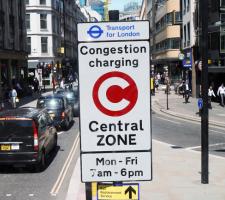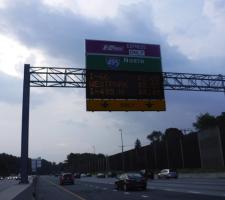
The widespread adoption of autonomous vehicles is likely to increase congestion, many experts believe. But Wes Guckert of Traffic Group believes that tolling could provide the answer
While it is still hard to wrap your head around the idea of getting into a vehicle without a driver, the industry is now used to hearing, reading, participating in the advancement of autonomous vehicles (AVs).
Those in the industry have heard about
Easing congestion
Most experts believe that the benefits associated with driverless technology could actually make current traffic congestion even worse! The appeal of starting the work day earlier on the morning commute or napping on the way home may encourage the use of AVs. And how appealing is it to remove the headache of searching for parking? About 30-60% of the cars driving around an urban area are just circling for open parking spaces. Worldwide, urban drivers spend an average of 20 minutes, per trip, looking for parking. The idea of getting picked up and dropped off right in front of a destination could also push the use of driverless. And if all these trips mirror the way people commute now — with a single occupant rather than carpooling — that could mean even more vehicles on the road creating greater traffic nightmares.
So what does congestion and driverless have to do with tolling? While it appears driverless cars will create more traffic, it seems our roadways are already at capacity - or beyond. It is important for cities across the globe to figure out their tolling strategies now, before AVs are mainstream.
London, Stockholm, Singapore and other cities around the globe have already begun charging more for vehicles operated during rush hour or in downtown or highway locations prone to congestion. In the US today, states like Texas, Colorado, Florida, North Carolina and Virginia are opening toll roads or lanes, or implementing congestion pricing to help curb traffic while also paying for the backlog of transportation and infrastructure projects.
Dynamic tolling
Dynamic tolling is suitable for both major freeways as well as congested urban areas. The word ‘dynamic’ - meaning constant change or constant activity - is fitting for a toll road that fluctuates rates depending on the amount of traffic congestion. The interesting thing about dynamic tolling (or congestion pricing) is that the fees can be scheduled, with the highest rates set during the busiest time(s) of day. Conversely, tolls can be left uncapped to fluctuate with changing traffic, as they do along the 10-mile stretch of I-66, where the rate hit $40 at 8.06am on a Tuesday late 2017. So far, 40 jurisdictions in the US have adopted dynamic tolling since Southern California adopted the first one in 1995.
While they are often criticised as ‘Lexus Lanes’, toll roads and congestion pricing really do work. As an example, along I-95 in Fairfax County, Virginia, there has been an average of 25% reduced delay in the general purpose lanes during commuting times. Those not involved in congestion pricing are reaping the rewards of those that are in the high-occupancy toll (HOT) lanes.
On a typical Thursday morning, I-95 express lanes offer significant time savings to all drivers. The general purpose lanes may run 18-50 minutes as you travel around the DC Beltway, whereas the I-495 express lanes can often be less than a 10-minute drive – a big difference during the morning rush! Keep in mind, congestion pricing can encourage mass transit use - or even carpooling.
Another reason we will continue to see tolling: gas tax revenue generated from gasoline is going to continue to drop. It will get to the point where electric vehicles will become a large portion of the automobile fleet and the amount of gasoline used will continue to decrease. As gasoline utilisation drops, so does the gas tax revenue. Lack of gas tax revenue will continue to reshape transportation industries as we know it.
In addition, right now in many states, electric vehicles (EVs) can travel toll-free on toll roads. In the future, all AVs will likely be electric.
City havoc
As a result of decades of mismanagement in various cities throughout the world, havoc has been wreaked on the transportation infrastructure, which is the root cause of so many traffic issues commuters encounter today.
In a recent study, the Partnership for New York City found that congestion costs the city $20 billion annually in lost time and revenue! Today, in midtown New York City, the average travel speed is less than 5mph.
Major cities throughout the US are currently studying whether or not they want to use dynamic congestion pricing in business districts as a way to help avoid ongoing intersection delay and gridlock. During the morning peak hour, it may cost $5 per vehicle to enter the city between 6am and 10am and then there might be no charge until noon, with another charge during the evening rush. Essentially, the more congested the roadways become, the higher the price a motorist has to pay.
Congestion pricing is touted as a viable solution for gridlock in cities. Although, initially, these types of surcharges were met with hostility, the positive effects have been hard to deny. Immediately following the initiation of zone charging, London saw congestion reduced by 25% and average travel speeds increased by 30%. Imagine what that would do to many businesses’ bottom lines, or how much faster a major construction project could be completed.
No free rides
Remember, there is no such thing as a free ride. Everything must be rationed when things are finite, such as capacity and roadways. This is not price gouging, rather, a simple matter of supply and demand. The thought process behind both dynamic tolling and congestion pricing is meant to move people, not cars.
Dynamic tolling and congestion pricing are necessary to help curb our world’s traffic issues, which eats into our global economy, quality of life, and environmental health. Think of this: even Disney World allows you to pay extra for the shorter line.













